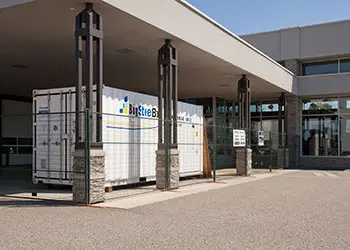
Employees meeting in office and over video conference
How To Set up a Hybrid Workplace and Welcome Employees Back to the Office
The residual effects of the COVID-19 pandemic on the workplace are still being felt, and will likely continue to be for many years to come. The pandemic essentially changed the way companies and employees viewed “the workplace”, and in particular, office workplaces.
When people weren’t able to be in close proximity to one another in an office, it forced many to work from home so that businesses could continue to operate. This resulted in a few realizations about the workplace, including:
- The understanding that people can be productive while working from home.
- Working from home can improve the work-life balance.
- Having less staff working in an office every day can cut company operating costs.
But, not everyone loves working from home all the time, and the isolation isn’t great for maintaining a strong company culture or team building. The solution many companies have chosen is a hybrid, flexible workplace where their staff are encouraged to embrace the happy medium of splitting their time between their home and corporate offices.
If you’re looking to set up a hybrid workplace, read on for tips and advice to make the process smooth for everyone involved.
Assess Your Workplace Needs
 Before you start implementing a hybrid workplace, you’ll need to evaluate your organization’s needs.
Before you start implementing a hybrid workplace, you’ll need to evaluate your organization’s needs.
Consider how much in-person collaboration is required, the types of technology and equipment that will be needed to support remote work, and what kind of workspace you’ll need to provide for employees when they are in the office.
You may also want to consider surveying your employees to see how they feel about the prospect of a hybrid workplace and what kind of support they feel they will need to be successful.
Define Your Company’s Hybrid Workplace
A successful hybrid workplace requires a flexible work policy that clearly outlines the expectations and requirements for both remote and in-person work. This policy should include guidelines for scheduling, communication, and collaboration, as well as rules for equipment and technology use. It should also address issues such as cybersecurity, data protection, and workplace safety.
How to Manage Office Space: Consider Hot Desking or Desk Hoteling
If desk space and office equipment are limited in your corporate shared office, you may find it helpful to implement a system to manage that space and ensure efficiency. Two possible options are hot desking and desk hoteling:
“The primary difference between hoteling and hot-desking is in the way employees can access desks in a workspace. Hot desking gives employees access to desks on a ‘first come, first-served’ basis, while hoteling requires employees to reserve desks in advance,” Kim Behnke, People Managing People.
Behnke continues to explain that hot desking is a workspace arrangement where some or no employee has a fixed spot. Instead, they can use desks that are available when they arrive. With desk hoteling, an employee must book a desk, usually with desk hoteling software, so when they visit the office they can only access the spot they booked, even if other desks are unoccupied.
Advantages to hot desking includes efficient use of office space that minimizes real estate risk, and also encourages employee innovation and collaboration. However, there are cons as well because without assigned seating it relies on desk availability, so seating isn’t guaranteed.
Much like an actual hotel operates, office or desk hotelling requires staff to make a reservation, check-in, and when they’re done, they check-out. Since hoteling involves allocating desks beforehand, it allows utilizing the space more effectively. The workspace will have greater occupancy because hoteling removes the uncertainty associated with the possible unavailability of desks.
Implementing a desk hoteling system usually requires shared internal software, such as Kadence or Deskfound, to manage workspace inventory and allow staff to see what is available, when it’s available, and to book their workspace in advance.
SAFTY NOTE: An important factor to remember with both hot desking and desk hotelling is that cleanliness and sanitation will become even more important.
With the rotating door of staff using shared computers, desks, keyboards, mice, etc, the chance of spreading viruses will increase. Provide disinfecting supplies like Lysol wipes at every workstation and encourage employees to wipe down their area before they begin work and at the end of each day before they leave. If you have professional cleaners in your office on a regular basis, ask them to clean high touch areas of workstations regularly as well.
Provide Technology and Equipment
 To support remote work, you’ll need to provide your employees with the technology and equipment they need to be successful. This may include laptops, monitors, desks, chairs and other hardware.
To support remote work, you’ll need to provide your employees with the technology and equipment they need to be successful. This may include laptops, monitors, desks, chairs and other hardware.
Having the right software applications and communication tools is also very important. After two years of social distancing, most office workers are experts with Zoom, Microsoft Teams or Google Meet by now! So, maintaining access to virtual meeting software and ensuring your employees have access to high-speed internet and any other necessary resources to support remote work will be imperative to creating a good hybrid workspace.
Create a Safe and Comfortable Workspace
When your employees are in the office, take the steps to provide a safe and comfortable workspace that supports collaboration and productivity, but keeps health and safety top of mind.
While most restrictions due to health concerns have been lifted, your company should have safety protocols and policies in place so that you’re prepared for future needs. This may include rearranging desks and workstations to allow for some physical distancing, having plexiglass barriers (or being prepared to install them if needed), and implementing regular cleaning and disinfecting protocols.
You will also want to communicate expectations to your staff when it comes to personal illness. In the past, many people “pushed through” and came to work when they were sick, but since then we’ve learned that this isn’t a good idea for anyone involved. Let staff know that if they’re not feeling well, they should stay home without feeling guilty. This is where the beauty of a hybrid workplace can really be seen, because if an employee feels they are contagious and could infect others, but feels well enough to work, then they’re able to safely do that from their home office.
 If you’re leading one of the many companies that chose to (or was forced to) downsize your workspace during the pandemic, but you still want to make space for staff to return to the office part of the time, you may need to store excess furniture, seasonal items, files, or anything that is taking up precious workspace.
If you’re leading one of the many companies that chose to (or was forced to) downsize your workspace during the pandemic, but you still want to make space for staff to return to the office part of the time, you may need to store excess furniture, seasonal items, files, or anything that is taking up precious workspace.
Portable storage is a great option if your office has room on the property for a storage container. In particular, shipping containers are a good storage solution because they’re made from steel, weather and rodent-proof and come equipped with a steel lock box that protects your items from theft.
Foster Collaboration and Communication
One of the biggest benefits of a hybrid workplace is the opportunity for collaboration and communication when employees are in the office. To make the most of this time, you’ll need to create opportunities and plan ahead for team members to connect and collaborate with activities such as team meetings, brainstorming sessions, and social events.
If some members of a team aren’t able to come into the office due to their location or limited office space, for example, make the effort to include them in team meetings by video conferencing so that there are opportunities for everyone to feel connected.
Offer Training and Support
Finally, it’s essential to offer training and support to help your employees navigate the transition to a hybrid workplace. This may include training on new technology and software, as well as guidance on how to balance remote and in-person work effectively.
Ideally, employers should provide additional resources such as mental health support and wellness programs to help employees manage the stress of a changing work environment, or any other challenges they may be dealing with.
Now you’re ready to get to work!
While setting up a hybrid workplace can be a complex and challenging process, it can also be an opportunity to create a more flexible, collaborative, and productive work environment. These tips along with open communication between management and their employees will help your team navigate this transition and move forward with confidence and excitement.



